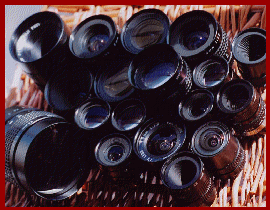| ||||||||||||||||||||||||||||
Welcome to the | ||||||||||||||||||||||||||||
 | ||||||||||||||||||||||||||||
 | ||||||||||||||||||||||||||||
Twenty years ago, the bulk of CCTV lens production was based squarely on manual iris lenses; the reason being that as ‘Vidicon’ tubed cameras were ‘de riguer’ for all internal applications, their extremely wide dynamic range meant that they could cope with most lighting conditions, so they didn't need an auto iris function. When the first generation of CCD & MOS solid state cameras were introduced, their dynamic range was so limiting that they almost always had to be fitted with automatiic iris lenses, simply to produce a correctly exposed image. As various improvements were made to achieve our present sophisticated CCD chip designs, with Electronic Iris option now almost standard on most cameras, we find ourselves in an ideal position to exploit the many beneficial characteristics of manual iris lenses ... and yet there is a problem. In the real world, most indoor cameras are operating under relatively controlled lighting conditions, and yet almost without exception, installers insist on fitting higher cost lower performance ‘auto iris’ lenses. How can this be? Well, if the lenses are higher cost, this generally equates to more profit ... need we say more? By the way, fixed ‘no iris’ lenses are ... a definite no no!! If you test any lens in an optical laboratory, whether its photographic, cine, video or CCTV, there is a fundamental principle that applies. Firstly, optical resolution, or if you prefer, the sharpness of the lens, will always be better at the centre of the image, than at the edges. | ||||||||||||||||||||||||||||
 | ||||||||||||||||||||||||||||
IMPORTANT: No material may be reproduced, copied or redistributed from this site, © doktorjon.co.uk 2004 - 2008 Homepage...:...Gateway...:...Technical Gateway....:....Quickfind Index....:....Equipment Directory | ||||||||||||||||||||||||||||

